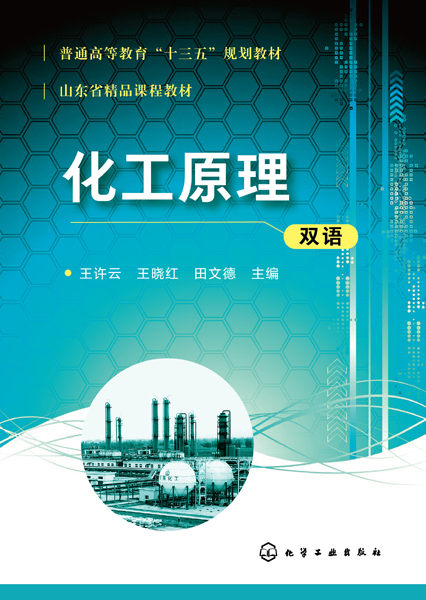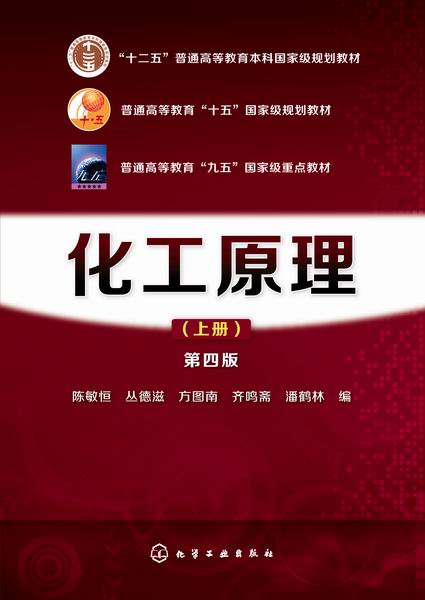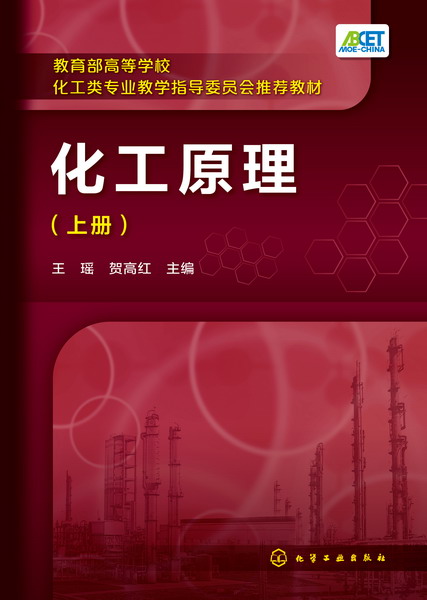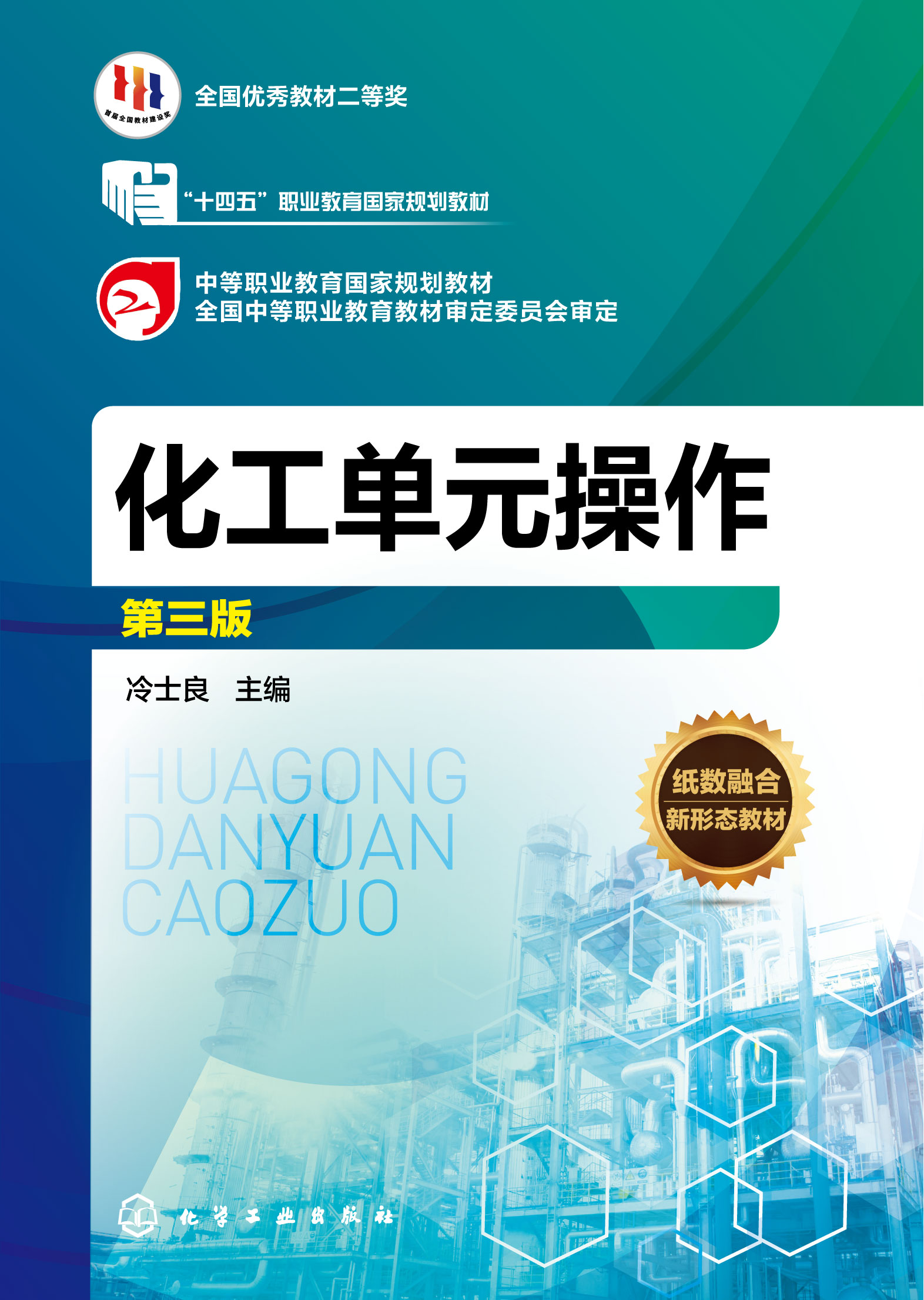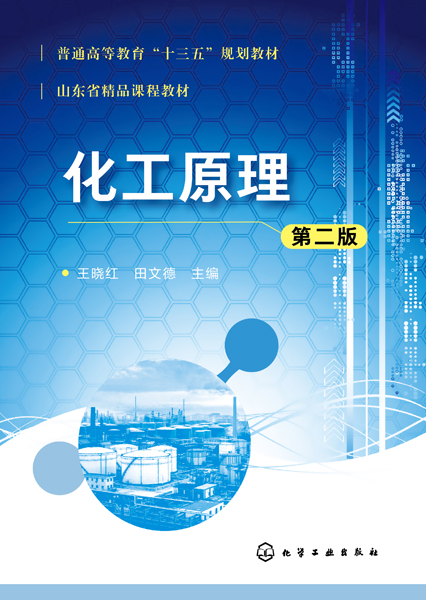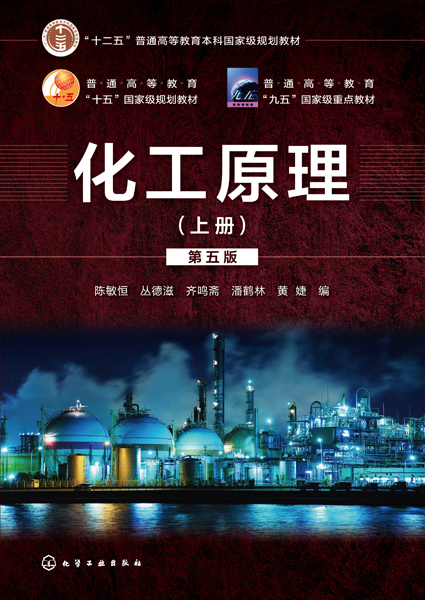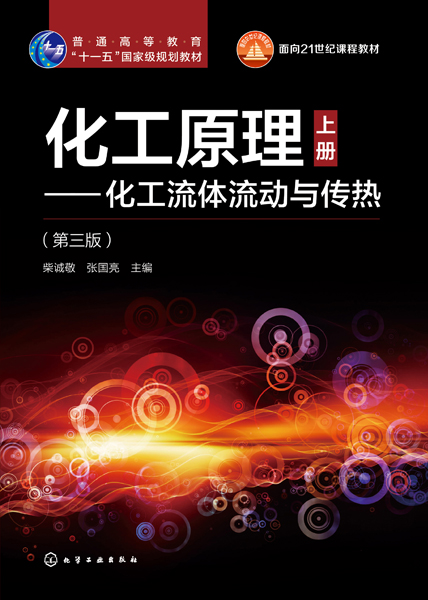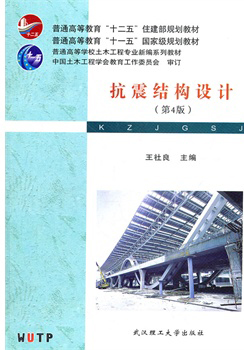- 化学工业出版社
- 9787122358226
- 1版
- 292326
- 60230805-8
- 16开
- 2019-12
- 747
- 467
- ①TQ02
- 化工类
- 本科
作者简介
内容简介
《化工原理》(双语)以动量、热量、质量传递理论为主线,系统简明地阐述了典型过程工程单元操作的基本原理、工艺计算、主要设备的结构特点及性能、过程或设备的强化途径等。内容包括流体流动原理及应用、传热及传热设备、传质原理及应用、固体颗粒流体力学基础与机械分离以及其他单元操作共五章。教材用中英文双语进行表达,教材与教学内容始终与国际接轨,使学生及时了解国内外相关学科发展前沿,同时为化工原理课程双语教学奠定基础。为保证教学效果,每章均配有习题、思考题、工程案例分析,可以引导读者应用所学知识,培养对复杂工程问题的深入分析和解决能力。
《化工原理》(双语)可作为高等学校化工及高分子、化学、材料、化工自动化、环境、化工安全、食品、制药、冶金等专业学生的教材,也可供从事科研、设计和实际生产的科技人员参考。
《化工原理》(双语)可作为高等学校化工及高分子、化学、材料、化工自动化、环境、化工安全、食品、制药、冶金等专业学生的教材,也可供从事科研、设计和实际生产的科技人员参考。
目录
0绪论(Introduction)/ 1
0.1化工原理课程的基本内容及特点/ 1
0.1.1单元操作(Unit operations)/ 1
0.1.2化工原理与其他课程的关系/ 2
0.1.3化工原理的任务及特点/ 3
0.2单位制与单位换算/ 5
0.2.1单位制(Unit systems)/ 5
0.2.2单位换算/ 5
0.2.3量纲分析/ 7
0.3基本概念与定律/ 8
0.3.1平衡关系及过程速率/ 8
0.3.2质量衡算/ 9
0.3.3能量衡算/ 10
0.4研究方法/ 10
第1章流体流动原理及应用
Chapter 1 Principles of Fluid Flow and Applications of Fluid/ 11
1.1流体基本概念(Basic Concepts of Fluid)/ 11
1.1.1流体特征(Nature of fluids)/ 11
1.1.2流体力学基本概念(Basic concepts of fluid mechanics)/ 12
1.1.3流体密度/ 13
1.2流体静力学(Fluid Statics)/ 14
1.2.1压强 (Pressure)/ 14
1.2.2流体静力学平衡 (Hydrostatic equilibrium)/ 17
1.2.3流体静力学方程应用(Application of fluid statics equation)/ 18
1.3流体流动的基本概念 (Basic Concepts of Fluid Flow)/ 21
1.3.1流量(Flow rate)与流速(Velocity)/ 21
1.3.2稳态流动(Steady-state flow)及非稳态流动(Unsteady-state flow)/ 22
1.3.3牛顿黏性定律 (Newton’s law of viscosity)/ 23
1.3.4流动型态(Types of fluid flow)/ 26
1.4流体流动的质量与能量衡算(Mass and Energy Balance of Fluid Flow)/ 32
1.4.1质量衡算——连续性方程(Mass balance——continuity equation)/ 32
1.4.2总能量衡算(Overall energy balance )/ 33
1.4.3流体流动的总机械能衡算式(Overall mechanical energy balance)——柏努利方程式(Bernoulli equation)/ 34
1.5流体流动阻力(Friction Loss of Fluid Flow)计算/ 38
1.5.1直管阻力(Friction loss in straight pipe )计算/ 38
1.5.2摩擦系数λ的确定/ 39
1.5.3局部阻力(Local friction loss)计算/ 45
1.6管路计算 (Calculation of Pipe Flow Systems)/ 46
1.6.1管路组成( Components of pipe flow systems)/ 46
1.6.2简单管路计算/ 53
1.6.3复杂管路计算/ 54
1.7流体输送机械 (Fluid Transportation Machinery)/ 55
1.7.1离心式输送机械(Centrifugal fluid transportation machinery)/ 55
1.7.2往复式输送机械 (Reciprocating conveying machinery)/ 78
1.7.3其他类型输送机械/ 81
1.8流速与流量测量(Metering of Fluid Flow Rate and Velocity)/ 86
1.8.1变压差恒截面型流量计/ 87
1.8.2恒压差变截面型流量计——转子流量计(Rotameters—area meter)/ 91
1.8.3涡轮流量计(Turbine flowmeter)/ 93
1.8.4电磁流量计(Electromagnetic flowmeter)/ 94
1.8.5超声波流量计(Ultrasonic flowmeter)/ 94
工程案例分析/ 95
习题/ 96
思考题/ 98
名词术语/ 98
第2章传热及传热设备
Chapter 2 Heat Transfer and Its Equipments/ 101
2.1传热基本概念(Basic Concepts of Heat Transfer)/ 101
2.1.1传热基本方式/ 102
2.1.2传热速率/ 102
2.2热传导(Heat Transfer by Conduction)/ 104
2.2.1热传导基本概念/ 104
2.2.2傅里叶定律(Fourier’s law)/ 105
2.2.3固体平壁稳态热传导/ 106
2.2.4固体圆筒壁稳态热传导(Steady-state conduction of heat flow through solid cylinders)/ 109
2.3对流传热 (Heat transfer by convection)/ 111
2.3.1牛顿冷却定律(Newton’s law of cooling)/ 112
2.3.2无相变对流传热(Heat transfer to fluids without phase change)系数计算/ 116
2.3.3有相变对流传热系数计算/ 121
2.4热辐射(Radiation Heat Transfer)/ 129
2.4.1辐射传热基本概念/ 129
2.4.2物体的辐射能力(Emissive power)/ 131
2.4.3物体间的辐射传热(Radiation between surfaces)/ 132
2.4.4对流与辐射联合传热/ 133
2.5间壁式换热器传热计算 (Calculation of Wall Heat-Exchange Equipments)/ 134
2.5.1间壁式换热简介(Introduction of wall heat-exchange equipments)/ 134
2.5.2热量衡算(Energy balances)/ 136
2.5.3总传热速率方程(Overrall rate equation of heat transfer)/ 137
2.5.4总传热系数(Overall heat-transfer coefficient)的确定 / 138
2.5.5平均传热温度差(Mean temperature difference)的计算/ 141
2.5.6换热器的传热计算/ 144
2.6换热设备(Heat Exchange Equipment)/ 149
2.6.1换热器类型/ 149
2.6.2强化传热途径/ 160
2.6.3管壳式换热器设计/ 161
工程案例分析/ 169
习题/ 170
思考题/ 171
名词术语/ 171
第3章传质原理及应用
Chapter 3 Principles of Mass Transfer and Applications/ 173
3.1传质基本概念(Basic Conceptions of Mass Transfer)/ 175
3.1.1分子扩散(Molecular diffusion)/ 175
3.1.2对流传质(Convective mass transfer)/ 180
3.2蒸馏(Distillation)/ 182
3.2.1气液相平衡原理/ 183
3.2.2蒸馏方式/ 189
3.2.3精馏原理 (Principles of distillation)/ 191
3.2.4精馏物料衡算与操作线方程(Material-balance and operating lines )/ 195
3.2.5精馏热量衡算/ 200
3.2.6精馏设计计算/ 203
3.2.7回流比的选择及影响/ 210
3.2.8特殊精馏(Special distillation)/ 215
3.2.9间歇精馏(Batch distillation)/ 218
3.3吸收 (Absorption)/ 219
3.3.1吸收基本原理 (Principles of absorption)/ 219
3.3.2气液相平衡关系(Gas-liquid equilibrium)/ 222
3.3.3吸收速率/ 226
3.3.4填料塔简介/ 230
3.3.5吸收剂用量计算/ 230
3.3.6吸收塔高度的计算(Fundamental calculation equation of packing height)/ 233
3.3.7其他/ 239
3.4萃取 (Extraction)/ 240
3.4.1萃取原理 (Principles of extraction)/ 240
3.4.2液-液相平衡 (Phase equilibria of liquid-liquid)/ 243
3.4.3萃取过程计算 (Calculations for extraction processes)/ 246
3.4.4新型萃取过程简介/ 250
3.5传质设备 (Mass Transfer Equipments)/ 252
3.5.1板式塔(Plate tower)/ 252
3.5.2填料塔(Packed tower)/ 261
3.5.3萃取设备(Extraction equipment)/ 271
工程案例分析/ 280
习题/ 281
思考题/ 284
名词术语/ 284
第4章固体颗粒流体力学基础与机械分离
Chapter 4 Solid Particles’ Fluid Mechanics Basis and Mechanical Separations/ 288
4.1固体颗粒特性(Characteristics of Solid Particles)/ 290
4.1.1单一颗粒特性(Characteristics of single particle)/ 290
4.1.2颗粒群的特性/ 291
4.1.3粒径测量(Particle size measurement)/ 292
4.2固体颗粒在流体中运动时的阻力(The Drag of Solid Particles Moving in the Fluid)/ 293
4.3沉降分离(Settling)/ 294
4.3.1重力沉降(Gravitational settling)/ 295
4.3.2离心沉降(Centrifugal settling)/ 299
4.4过滤(Filtration)/ 306
4.4.1过滤原理(Filtration fundamentals)/ 306
4.4.2过滤基本方程式/ 309
4.4.3过滤设备(Filtering equipment)/ 310
4.4.4过滤操作的改进(Improvement of filtering operations)/ 314
4.5固体流态化(Fluidization of Solid Particles)/ 314
4.5.1固体流态化现象(Fluidization of solids)/ 314
4.5.2固体流态化流体力学特性/ 316
4.5.3分布板对流化质量的影响/ 319
4.5.4固体流态化技术的应用(Application of solid fluidization technology)/ 320
4.6其他机械分离技术(Other Mechanical Separations)/ 322
4.6.1静电除尘(Electrostatic dust collection)/ 322
4.6.2湿法捕集/ 323
工程案例分析/ 325
习题/ 326
思考题/ 328
名词术语/ 328
第5章其他单元操作
Chapter 5 Others Unit Operation/ 330
5.1蒸发(Evaporation)/ 331
5.1.1蒸发设备(Evaporation equipments)/ 332
5.1.2单效蒸发(Single-effect evaporation)/ 339
5.1.3多效蒸发(Multiple-effect evaporators)/ 341
5.1.4蒸发操作的其他节能措施(Other energy saving measures for evaporation operations)/ 346
5.1.5蒸发应用/ 347
5.2固体干燥(Drying of Solid)/ 350
5.2.1干燥基本概念(Basic conception of drying)/ 351
5.2.2湿空气性质(Properties of moist air)/ 353
5.2.3干燥工艺计算(Calculation of drying technology)/ 359
5.2.4干燥动力学(Dynamics of drying)/ 361
5.2.5干燥设备(Drying equipment)/ 368
5.3膜分离技术(Membrane Separation Technology)/ 372
5.3.1膜分离技术发展简介/ 372
5.3.2各种固体膜分离过程简介(Introduction of various solid membrane separation process)/ 374
5.3.3液膜分离技术(Technology of liquid membrane separation)/ 378
5.3.4膜蒸馏/ 382
5.3.5膜的性能参数/ 383
5.3.6典型膜分离设备简介/ 384
5.4结晶(Crystallization)/ 389
5.4.1结晶的基本概念(Basic concepts of crystallization)/ 389
5.4.2相平衡与溶解度(Phase equilibrium and solubility)/ 392
5.4.3结晶动力学简介/ 393
5.4.4工业结晶方法与设备(Industrial crystallization methods and equipments)/ 396
5.4.5结晶过程的强化与展望(Strengthening and prospect of crystallization process)/ 400
5.5吸附(Adsorption)/ 400
5.5.1吸附现象及其工业应用/ 400
5.5.2吸附的工业应用/ 405
5.5.3工业吸附方法与设备/ 406
5.6离子交换(Ion Exchange)/ 410
5.6.1离子交换原理 / 410
5.6.2离子交换剂的种类/ 413
5.6.3离子交换树脂的基本性质/ 416
5.6.4离子交换树脂的选用/ 418
5.6.5离子交换工业流程及设备/ 419
工程案例分析/ 425
思考题/ 432
名词术语/ 433
附录/ 436
参考文献/ 467
0.1化工原理课程的基本内容及特点/ 1
0.1.1单元操作(Unit operations)/ 1
0.1.2化工原理与其他课程的关系/ 2
0.1.3化工原理的任务及特点/ 3
0.2单位制与单位换算/ 5
0.2.1单位制(Unit systems)/ 5
0.2.2单位换算/ 5
0.2.3量纲分析/ 7
0.3基本概念与定律/ 8
0.3.1平衡关系及过程速率/ 8
0.3.2质量衡算/ 9
0.3.3能量衡算/ 10
0.4研究方法/ 10
第1章流体流动原理及应用
Chapter 1 Principles of Fluid Flow and Applications of Fluid/ 11
1.1流体基本概念(Basic Concepts of Fluid)/ 11
1.1.1流体特征(Nature of fluids)/ 11
1.1.2流体力学基本概念(Basic concepts of fluid mechanics)/ 12
1.1.3流体密度/ 13
1.2流体静力学(Fluid Statics)/ 14
1.2.1压强 (Pressure)/ 14
1.2.2流体静力学平衡 (Hydrostatic equilibrium)/ 17
1.2.3流体静力学方程应用(Application of fluid statics equation)/ 18
1.3流体流动的基本概念 (Basic Concepts of Fluid Flow)/ 21
1.3.1流量(Flow rate)与流速(Velocity)/ 21
1.3.2稳态流动(Steady-state flow)及非稳态流动(Unsteady-state flow)/ 22
1.3.3牛顿黏性定律 (Newton’s law of viscosity)/ 23
1.3.4流动型态(Types of fluid flow)/ 26
1.4流体流动的质量与能量衡算(Mass and Energy Balance of Fluid Flow)/ 32
1.4.1质量衡算——连续性方程(Mass balance——continuity equation)/ 32
1.4.2总能量衡算(Overall energy balance )/ 33
1.4.3流体流动的总机械能衡算式(Overall mechanical energy balance)——柏努利方程式(Bernoulli equation)/ 34
1.5流体流动阻力(Friction Loss of Fluid Flow)计算/ 38
1.5.1直管阻力(Friction loss in straight pipe )计算/ 38
1.5.2摩擦系数λ的确定/ 39
1.5.3局部阻力(Local friction loss)计算/ 45
1.6管路计算 (Calculation of Pipe Flow Systems)/ 46
1.6.1管路组成( Components of pipe flow systems)/ 46
1.6.2简单管路计算/ 53
1.6.3复杂管路计算/ 54
1.7流体输送机械 (Fluid Transportation Machinery)/ 55
1.7.1离心式输送机械(Centrifugal fluid transportation machinery)/ 55
1.7.2往复式输送机械 (Reciprocating conveying machinery)/ 78
1.7.3其他类型输送机械/ 81
1.8流速与流量测量(Metering of Fluid Flow Rate and Velocity)/ 86
1.8.1变压差恒截面型流量计/ 87
1.8.2恒压差变截面型流量计——转子流量计(Rotameters—area meter)/ 91
1.8.3涡轮流量计(Turbine flowmeter)/ 93
1.8.4电磁流量计(Electromagnetic flowmeter)/ 94
1.8.5超声波流量计(Ultrasonic flowmeter)/ 94
工程案例分析/ 95
习题/ 96
思考题/ 98
名词术语/ 98
第2章传热及传热设备
Chapter 2 Heat Transfer and Its Equipments/ 101
2.1传热基本概念(Basic Concepts of Heat Transfer)/ 101
2.1.1传热基本方式/ 102
2.1.2传热速率/ 102
2.2热传导(Heat Transfer by Conduction)/ 104
2.2.1热传导基本概念/ 104
2.2.2傅里叶定律(Fourier’s law)/ 105
2.2.3固体平壁稳态热传导/ 106
2.2.4固体圆筒壁稳态热传导(Steady-state conduction of heat flow through solid cylinders)/ 109
2.3对流传热 (Heat transfer by convection)/ 111
2.3.1牛顿冷却定律(Newton’s law of cooling)/ 112
2.3.2无相变对流传热(Heat transfer to fluids without phase change)系数计算/ 116
2.3.3有相变对流传热系数计算/ 121
2.4热辐射(Radiation Heat Transfer)/ 129
2.4.1辐射传热基本概念/ 129
2.4.2物体的辐射能力(Emissive power)/ 131
2.4.3物体间的辐射传热(Radiation between surfaces)/ 132
2.4.4对流与辐射联合传热/ 133
2.5间壁式换热器传热计算 (Calculation of Wall Heat-Exchange Equipments)/ 134
2.5.1间壁式换热简介(Introduction of wall heat-exchange equipments)/ 134
2.5.2热量衡算(Energy balances)/ 136
2.5.3总传热速率方程(Overrall rate equation of heat transfer)/ 137
2.5.4总传热系数(Overall heat-transfer coefficient)的确定 / 138
2.5.5平均传热温度差(Mean temperature difference)的计算/ 141
2.5.6换热器的传热计算/ 144
2.6换热设备(Heat Exchange Equipment)/ 149
2.6.1换热器类型/ 149
2.6.2强化传热途径/ 160
2.6.3管壳式换热器设计/ 161
工程案例分析/ 169
习题/ 170
思考题/ 171
名词术语/ 171
第3章传质原理及应用
Chapter 3 Principles of Mass Transfer and Applications/ 173
3.1传质基本概念(Basic Conceptions of Mass Transfer)/ 175
3.1.1分子扩散(Molecular diffusion)/ 175
3.1.2对流传质(Convective mass transfer)/ 180
3.2蒸馏(Distillation)/ 182
3.2.1气液相平衡原理/ 183
3.2.2蒸馏方式/ 189
3.2.3精馏原理 (Principles of distillation)/ 191
3.2.4精馏物料衡算与操作线方程(Material-balance and operating lines )/ 195
3.2.5精馏热量衡算/ 200
3.2.6精馏设计计算/ 203
3.2.7回流比的选择及影响/ 210
3.2.8特殊精馏(Special distillation)/ 215
3.2.9间歇精馏(Batch distillation)/ 218
3.3吸收 (Absorption)/ 219
3.3.1吸收基本原理 (Principles of absorption)/ 219
3.3.2气液相平衡关系(Gas-liquid equilibrium)/ 222
3.3.3吸收速率/ 226
3.3.4填料塔简介/ 230
3.3.5吸收剂用量计算/ 230
3.3.6吸收塔高度的计算(Fundamental calculation equation of packing height)/ 233
3.3.7其他/ 239
3.4萃取 (Extraction)/ 240
3.4.1萃取原理 (Principles of extraction)/ 240
3.4.2液-液相平衡 (Phase equilibria of liquid-liquid)/ 243
3.4.3萃取过程计算 (Calculations for extraction processes)/ 246
3.4.4新型萃取过程简介/ 250
3.5传质设备 (Mass Transfer Equipments)/ 252
3.5.1板式塔(Plate tower)/ 252
3.5.2填料塔(Packed tower)/ 261
3.5.3萃取设备(Extraction equipment)/ 271
工程案例分析/ 280
习题/ 281
思考题/ 284
名词术语/ 284
第4章固体颗粒流体力学基础与机械分离
Chapter 4 Solid Particles’ Fluid Mechanics Basis and Mechanical Separations/ 288
4.1固体颗粒特性(Characteristics of Solid Particles)/ 290
4.1.1单一颗粒特性(Characteristics of single particle)/ 290
4.1.2颗粒群的特性/ 291
4.1.3粒径测量(Particle size measurement)/ 292
4.2固体颗粒在流体中运动时的阻力(The Drag of Solid Particles Moving in the Fluid)/ 293
4.3沉降分离(Settling)/ 294
4.3.1重力沉降(Gravitational settling)/ 295
4.3.2离心沉降(Centrifugal settling)/ 299
4.4过滤(Filtration)/ 306
4.4.1过滤原理(Filtration fundamentals)/ 306
4.4.2过滤基本方程式/ 309
4.4.3过滤设备(Filtering equipment)/ 310
4.4.4过滤操作的改进(Improvement of filtering operations)/ 314
4.5固体流态化(Fluidization of Solid Particles)/ 314
4.5.1固体流态化现象(Fluidization of solids)/ 314
4.5.2固体流态化流体力学特性/ 316
4.5.3分布板对流化质量的影响/ 319
4.5.4固体流态化技术的应用(Application of solid fluidization technology)/ 320
4.6其他机械分离技术(Other Mechanical Separations)/ 322
4.6.1静电除尘(Electrostatic dust collection)/ 322
4.6.2湿法捕集/ 323
工程案例分析/ 325
习题/ 326
思考题/ 328
名词术语/ 328
第5章其他单元操作
Chapter 5 Others Unit Operation/ 330
5.1蒸发(Evaporation)/ 331
5.1.1蒸发设备(Evaporation equipments)/ 332
5.1.2单效蒸发(Single-effect evaporation)/ 339
5.1.3多效蒸发(Multiple-effect evaporators)/ 341
5.1.4蒸发操作的其他节能措施(Other energy saving measures for evaporation operations)/ 346
5.1.5蒸发应用/ 347
5.2固体干燥(Drying of Solid)/ 350
5.2.1干燥基本概念(Basic conception of drying)/ 351
5.2.2湿空气性质(Properties of moist air)/ 353
5.2.3干燥工艺计算(Calculation of drying technology)/ 359
5.2.4干燥动力学(Dynamics of drying)/ 361
5.2.5干燥设备(Drying equipment)/ 368
5.3膜分离技术(Membrane Separation Technology)/ 372
5.3.1膜分离技术发展简介/ 372
5.3.2各种固体膜分离过程简介(Introduction of various solid membrane separation process)/ 374
5.3.3液膜分离技术(Technology of liquid membrane separation)/ 378
5.3.4膜蒸馏/ 382
5.3.5膜的性能参数/ 383
5.3.6典型膜分离设备简介/ 384
5.4结晶(Crystallization)/ 389
5.4.1结晶的基本概念(Basic concepts of crystallization)/ 389
5.4.2相平衡与溶解度(Phase equilibrium and solubility)/ 392
5.4.3结晶动力学简介/ 393
5.4.4工业结晶方法与设备(Industrial crystallization methods and equipments)/ 396
5.4.5结晶过程的强化与展望(Strengthening and prospect of crystallization process)/ 400
5.5吸附(Adsorption)/ 400
5.5.1吸附现象及其工业应用/ 400
5.5.2吸附的工业应用/ 405
5.5.3工业吸附方法与设备/ 406
5.6离子交换(Ion Exchange)/ 410
5.6.1离子交换原理 / 410
5.6.2离子交换剂的种类/ 413
5.6.3离子交换树脂的基本性质/ 416
5.6.4离子交换树脂的选用/ 418
5.6.5离子交换工业流程及设备/ 419
工程案例分析/ 425
思考题/ 432
名词术语/ 433
附录/ 436
参考文献/ 467

